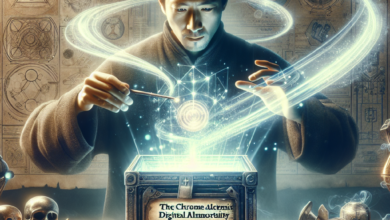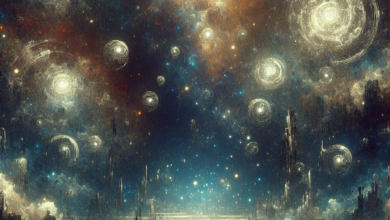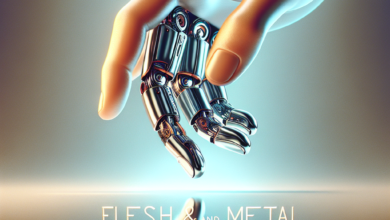The Quantum Paradox
Chapter 1: The Whispering Particles
In the small, dimly lit laboratory of Dr. Eleanor Shaw, the soft hum of machinery was the only sound that filled the air. Crates of equipment lay scattered across the room, each labeled with a variety of cryptic symbols and numbers. Among them, an oversized, state-of-the-art particle accelerator gleamed under the fluorescent lights, casting long shadows that danced on the walls.
Dr. Shaw was renowned in the field of quantum physics, having spent the last two decades investigating the quirks and curiosities of the quantum realm. Her team had been tasked with exploring the fundamental nature of reality, with a particular interest in a dazzling theory known as the Quantum Paradox. It was an ambitious project; the theory posited that particles could exist in multiple states simultaneously, and with the right conditions, those states could overlap, creating possibilities that defied human understanding.
Eleanor adjusted her glasses and peered at the complex display on her console. There were only a few hours left until the experiment commenced, and she could feel the weight of anticipation building in her chest. Today was the day they would test a unique hypothesis: whether it was possible to manipulate particles in such a way that the observer’s consciousness could influence their state—a direct query into the age-old question of the observer effect.
Her assistant, a sprightly graduate student named Leo, burst into the lab, an unmistakable glint of excitement in his eyes. “Dr. Shaw! You need to see this!”
“What is it, Leo?” she asked, standing and smoothing her lab coat.
He rushed to her side, pointing at a chaotic string of data streaming across the monitor. “The calibration tests show anomalies in the particles we’ve been using! I think they’re—”
He paused, searching for the words. “They’re responding to our thoughts.”
Eleanor’s heart raced. “That’s impossible. The observer effect has been well-documented, but that’s entirely different. You mean to say that they’re—”
“Exactly! They seem to change their states depending on our expectations. It’s like they’re… listening.”
Eleanor had read experimental reports that flirted with such ideas—psychological influences on quantum systems—but they were always dismissed as mere conjecture. Yet here was Leo, bubbling with enthusiasm. He was right; the implications were staggering. Had they stumbled onto something profound—or dangerous?
Chapter 2: The Experiment
At precisely two o’clock, the research team gathered for the experiment. The air crackled with tension, and Eleanor took a deep breath, steadying herself. Everyone assembled in the semi-dark control room behind the glass wall that overlooked the accelerator chamber. There, small metallic spheres containing a blend of subatomic particles awaited activation.
“Remember,” Eleanor reminded them, her voice steady despite her racing thoughts. “We’re here to observe the behavior of the particles, not to influence them intentionally. Clear your minds. Focus on the data.”
As the countdown began, Eleanor’s heart quickened. She activated the system. There was a low thrum as the accelerator powered up, and the particles ignited in a brilliant flash of lights, swirling around like ethereal fireflies on the screen.
Moments later, the display showed an array of probabilities, particles blinking in and out of existence, forming and collapsing into various states. Then something remarkable happened.
One of the observers, a physicist named Kamala, gasped. “They’re… they’re not behaving randomly. It’s like they’re following a pattern based on our thoughts.”
Driven by curiosity, Eleanor decided to run a different kind of test, one that would force them to engage mentally with the particles.
“Let’s visualize what we want them to do,” she said. “If they are responding to us in any way, we should be able to direct their behavior.”
The team closed their eyes, focusing intently on a single idea: “Let’s make the particle split and remain in sync.”
When they opened their eyes, the data on the screen exploded with clarity—two distinct particles flickered in and out of existence, locked together, resonating at harmonically perfect frequencies. The ionic tubes glowed like veins of light pulsing to a steady rhythm.
Leo turned to Eleanor, his expression a mixture of awe and fear. “Do you think… do you think it’s real?”
Eleanor nodded slowly, yet doubt nagged at the corners of her mind. How could they have affected the particles? She worried they might be trespassing into realms better left unexplored.
Chapter 3: The Tipping Point
Over the next few days, excitement bubbled within the lab. The experimentation continued; the particles began to yield results that seemed almost… sentient. Each session unveiled fresh revelations, phenomena that resembled consciousness reflecting in the behaviors of the particles. Yet, with every revelation came a growing sense of unease.
One evening, Eleanor reviewed the data from their last two sessions, her brows furrowing deeper with each line of numbers. Something was off. Strange patterns began to emerge, signatures that seemed almost like a coded language beneath the chaos—an entangling web that suggested something intelligent was at play.
“Eleanor?” Leo whispered, standing at her shoulder. “Are you okay?”
“No,” she replied, biting her lip. “I’m worried. If these particles are indeed responding to our consciousness, we must consider the ethical implications. It feels as if we’re tampering with something we don’t fully understand.”
Leo flinched. “You think we should stop?”
“Not yet,” Eleanor replied, a small spark of defiance igniting inside her. “We’re on the brink of a groundbreaking discovery. We just need to tread carefully.”
But as the experiments progressed, Eleanor began to notice strange occurrences. Subtle disturbances in the lab, fluctuations in equipment readings, whispers among the team—those random comments that made the hair on the back of her neck stand on end. The particles displayed behaviors that evoked more than mere curiosity; they felt intelligent, almost aware of human moods as they danced vibrantly on the display, preceding predictable fluctuations, suddenly porpoising between states in seemingly mischievous ways.
One starlit night, while she was alone in the lab, Eleanor decided to confront the particles directly. She stood before the screen, her heart racing. “If you can hear me,” she spoke softly, “show me a sign.”
She closed her eyes, focusing her mind on a simple request. When she opened them again, the display flickered violently; chaotic bursts of light lit up the darkened lab. The particles shifted from one state to another, spinning wildly before settling into a perfect formation—an intricate spiral, unlike anything Eleanor had ever seen before.
“It’s not just randomness,” she murmured, her breath hitching in her throat. “They’re communicating.”
Chapter 4: The Collapse
The team’s exhilaration quickly devolved into chaos. Seemingly minor fluctuations had spiraled into something larger, an energetic resonance the lab had never seen before. Discussions grew heated; some members, enthralled by the quest for knowledge, encouraged further experimentation, while others feared the unknown consequences.
Eleanor’s internal conflict grew louder, but she felt compelled, chased by the sheer thrill of discovery. Perhaps this was what humanity had sought for eons: a bridge between consciousness and the fabric of reality.
Yet, one evening, during an experiment, calamity struck. The accelerator malfunctioned, sending waves of energy echoing through the space. Light exploded across the lab, a luminous surge. The room reverberated violently; monitors shattered, and a palpable sense of dread unfurled.
“Get to safety!” Eleanor shouted, but the team was paralyzed, their eyes transfixed by the chaotic spirals forming from the particles. A sudden surge lashed through the containment field, rippling into the very fabric of existence.
In an instant, everything changed.
Chapter 5: The Quantum Echo
Eleanor awoke in an unfamiliar place, disoriented and confused. The lab was gone. She had landed in a vast expanse of shimmering particles suspended in a void, the edges of reality curling in on themselves like paper bound by gravity. She felt an echo of familiarity circulate around her.
“Eleanor…,” a voice called softly, echoing like a distant whisper.
“Who’s there?” She found herself standing, limbs swaying unsteadily.
A silhouette began to form amidst the luminescent particles—a version of herself, ethereal and translucent, shimmering like the very particles they had been studying. “You’ve crossed over,” the echoing apparition spoke, “into the realm of quantum consciousness.”
“Crossed over?” Eleanor echoed. “What do you mean?”
“Your observations have shaken the boundaries of what you believed to be real. Conscious thought can manipulate existence. You’ve sparked an awakening, Eleanor. But that awakening carries consequences.”
“Consequences?” she asked, dread pooling in her stomach. “What have we done?”
The echo folded its hands, gesturing to the swirling light. “The Quantum Paradox has no respecter of boundaries. You are not merely observers; you are participants in the dance of creation. But with that comes a power you cannot fathom.”
As the echo shimmered, a kaleidoscope of visions spun around Eleanor—each representing a different branch of reality emergent from the quantum void. She glimpsed the lives not lived, paths that forked and diverged based on thoughts and choices made, numerous realities strung together by the threads of their consciousness.
“I see…” she whispered, a wave of understanding washing over her. “But we were only trying to understand.”
“You have grown beyond the horizon of comprehension. Knowledge has led you here, but it may demand a price.”
“What do we have to do?” she asked fervently.
“There’s a choice to make, for every knowing has its weight. You can return to your world and forget—all you’ve learned, though this will impact your collective reality. Or remain in this space, risking everything to embrace what lies beyond.”
Eleanor faltered. To return would mean erasing everything they had uncovered, but remaining risked opening doors they weren’t prepared to face. She thought of Leo, of her team, of the mounting implications of their experiments. What choice would she make?
Chapter 6: The Choice
With a swell of determination, Eleanor stood tall, even amidst uncertainty. “I refuse to retreat,” she proclaimed. “If we can manipulate the foundations of existence, we deserve to understand the consequences—not in fear, but in responsibility…”
“Then you must act swiftly,” the echo replied. “The very essence of your reality is in turmoil. Your team is at a tipping point. To remain plays havoc with timelines, constraining fates for others while shaping your own.”
“What do I need to do?” she pressed.
“Manifest your will through thought. Bind your consciousness with those anchored in the realm of reality, weave their intent into a new tapestry. Together, you can stabilize what has been fractured.”
Eleanor inhaled deeply, channeling her own consciousness, reaching out to the quantum realm beyond. “Everyone, hear me!” she called, directing her thoughts into the void. “Together, we can reshape our reality. Align your intentions with mine. Visualize stability, clarity, purpose.”
The shimmering fragments pulsated in response, resonating with Eleanor’s voice as if listening to her thoughts, like waves of energy swirling around her. She felt their connections, the bond they shared reverberate as it thrummed in time with her focus. Strands of reality began to weave together again, binding the chaos.
Suddenly, Eleanor felt a jarring shift; it was as though she were being pulled, yanked back toward her original form, and with a burst of brilliance, she surrendered.
Chapter 7: The Return
Eleanor opened her eyes, gasping as colors swirled before her. She was lying on the laboratory floor, her team surrounding her, their faces stricken with shock and relief.
“What happened?” Leo asked, kneeling beside her. “You just… disappeared. And then there was this surge—we thought we lost you.”
Eleanor blinked, her mind racing through the experience she had just endured. “The particles, they… they transcended us. We… created instability.”
The team exchanged looks of confusion and fear. Eleanor pushed herself to her feet. “We crossed the line. From here onward, we must proceed with vigilance. We’ve unlocked something profound, but we must respect its power. No more experiments without thorough understanding.”
“But we could be on the cusp of a scientific revolution!” Kamala protested, eyes alight with ambition.
“Or the beginning of our downfall,” Eleanor countered. “From now on, we focus not on what we can do, but what we should do.”
And so, as the hum of the lab returned to its usual whir, Eleanor and her team began a new chapter—one that explored not the manipulation of particles, but the ethical considerations of their revelations.
In harnessing the Quantum Paradox, they had not just gained knowledge of existence; they had been gifted a responsibility—a chance to align their consciousness with the greater tapestry of reality in a delicate balance between power and reverence.
Epilogue: The Ripple Effect
In the years that followed, Eleanor’s shift in philosophy grew into a movement. The concepts they had explored began to ripple beyond the confines of the lab, inspiring discourse on consciousness and reality across the globe.
Through the careful melding of science and thought, a new paradigm emerged, one that explored not just the minutiae of particles, but the interconnectedness of humanity and existence itself.
The universe was no longer a chaotic set of interacting systems; instead, it became a symphony—a profound harmony where even the smallest note played a vital role in the greater design.
And for Eleanor, it was a reminder of their adventure—the Quantum Paradox was not just a theoretical possibility; it was the intersection of intention and reality, a conscious act of creation waiting to be explored, but always with respect.
And so, the true paradox remained: the more they understood, the more they realized there was to learn, and the quest became not just to manipulate reality, but to celebrate the beautiful complexity of all that was yet to come.





